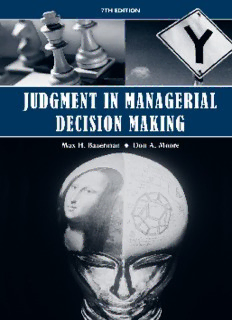
Judgment in Managerial Decision Making PDF
Preview Judgment in Managerial Decision Making
JUDGMENT IN MANAGERIAL DECISION MAKING SEVENTH EDITION Max H. Bazerman Harvard Business School Don A. Moore Carnegie Mellon University JOHN WILEY & SONS, INC. ExecutivePublisher DonFowley ProductionAssistant MattWinslow ProductionManager DorothySinclair ExecutiveMarketingManager AmyScholz MarketingCoordinator CarlyDecandia CreativeDirector JeofVita Designer JimO’Shea ProductionManagementServices ElmStreetPublishingServices ElectronicComposition ThomsonDigital EditorialProgramAssistant CarissaMarker SeniorMediaEditor AllisonMorris CoverPhoto CorbisDigitalStock(topleft), PhotoDisc/GettyImages(topright), andPhotoDisc,Inc.(bottom) Thisbookwassetin10/12NewCaledoniabyThomsonDigitalandprintedandboundbyCourier/Westford. ThecoverwasprintedbyCourier/Westford. Thisbookisprintedonacidfreepaper. Copyright#2009JohnWiley&Sons,Inc.Allrightsreserved.Nopartofthispublicationmaybe reproduced,storedinaretrievalsystemortransmittedinanyformorbyanymeans,electronic,mechanical, photocopying,recording,scanningorotherwise,exceptaspermittedunderSections107or108ofthe1976 UnitedStatesCopyrightAct,withouteitherthepriorwrittenpermissionofthePublisher,orauthorization throughpaymentoftheappropriateper-copyfeetotheCopyrightClearanceCenter,Inc.,222Rosewood Drive,Danvers,MA01923,websitewww.copyright.com.RequeststothePublisherforpermissionshould beaddressedtothePermissionsDepartment,JohnWiley&Sons,Inc.,111RiverStreet,Hoboken,NJ 07030-5774,(201)748-6011,fax(201)748-6008,websitehttp://www.wiley.com/go/permissions. Toorderbooksorforcustomerserviceplease,call1-800-CALLWILEY(225-5945). LibraryofCongressCataloging-in-PublicationData Bazerman,MaxH. Judgmentinmanagerialdecisionmaking/MaxH.Bazerman,DonMoore.—7thed. p.cm Includesbibliographicalreferencesandindex. ISBN-13:978-0-470-04945-7(cloth:acidfreepaper) ISBN-10:0-470-04945-6(cloth:acidfreepaper) 1.Decisionmaking. 2.Judgment. 3.Management, I.Moore,DonA.,1970– II.Title. HD30.23.B382009 0 658.403—dc22 2008008490 PrintedintheUnitedStatesofAmerica 10 9 8 7 6 5 4 3 2 1 Dedicated to MHB: To Howard Raiffa, for his influence on the field of decision making and on me DAM: To my dad, for his influence on me and my decision making This page intentionally left blank P R E F A C E Between 1981 and 1983, one of us (Max) served on the faculty of Boston Univer- sity.Atthetime,hewasconductinglaboratorystudiesondecisionbiasesinnegotiation. Behavioral decision research did not exist as a topic of study in most management schools. The faculty at Boston University included a number of excellent colleagues, and yet they knew very little about the emerging research on judgment. This lack of awareness among management colleagues motivated Max to write this book. The goal was to make the area of judgment a more central part of the management literature. Anothergoalwastopresentthisinformationtomanagers,students,andresearchersin an interesting manner that would improve their judgment capabilities. Max wrote the first edition of this book with no expectation that he would be revising it to create the seventheditionsomanyyearslater. Behavioraldecisionresearchhasdevelopedconsiderablyoverthepasttwenty-five years, and now provides many important insights into managerial behavior. This book embeds behavioral decisionresearch intothe organizationalrealmbyexamining judg- ment in a variety of managerial contexts. The audience for this book is anyone who is interestedinimprovinghisorherjudgmentanddecisionmaking.Thefirstsixeditions wereusedineconomics,psychology,decisionmaking,negotiations,andorganizational behavior courses, and in a variety of executive programs as well. For the psychology audience, the book offers a systematic framework for using psychological findings to improvejudgment.Fortheeconomicsaudience,thebookoffersacritiqueoftheclassic economicmodelofdecisionmaking.Andfortheconsumer,management,andfinancial communities,thisbookcreatesopportunitiestomakebetterdecisions. Excellent colleagues have been the primary source of ideas in this book. These colleaguesincludeLindaBabcock,MahzarinBanaji,JonBaron,YoellaBereby-Meyer, John Beshears, SallyBlount, IrisBohnet,Jeanne Brett, Art Brief,JoelBrockner, Day- lian Cain, John Carroll, Eugene Caruso, Dolly Chugh, Ed Conlon, Tina Diekmann, Nick Epley,HankFarber, Marla Felcher,AdamGalinsky, Steve Garcia, Dedre Gent- ner,DanGilbert,JamesGillespie,FrancescaGino,LindaGinzel,BritGrosskopf,Tim Hall,AndyHoffman,ChrisHsee,LorraineIdson,DonJacobs,HarryKatz,BoazKey- sar, Tom Kochan, Terri Kurtzberg, Jenn Lerner, Roy Lewicki, George Loewenstein, BetaMannix,LeighMcAlister,KathleenMcGinn,BobMcKersie,DougMedin,David Messick,KatyMilkman,DonMoore,SimoneMoran,KeithMurnighan,MaggieNeale, TerryOdean,HowardRaiffa,ToddRogers,LeeRoss,AlRoth,JeffRubin,BillSamuel- son,DavidSchoorman,HollySchroth,PriShah,ZachSharek,DebSmall,HarrisSon- dak, Sam Swift, Ann Tenbrunsel, Leigh Thompson, Cathy Tinsley, Mike Tushman, Kimberly Wade-Benzoni, Michael Watkins, Toni Wegner, Dan Wegner, and Jason Zweig. v vi (cid:2) Preface The seventh edition saw Don join as a co-author, and extensive updating of the materialthroughoutthebook.Newmaterialintheseventheditionincorporatesrecent researchthatwehavedonewithDaylianCain,EugeneCaruso,NickEpley,Francesca Gino,KatyMilkman,ToddRogers,andothers.UrielHaranofferedimportantsugges- tionsontherevisionsfortheseventhedition. Finally, the book has benefited from fantastic editorial help. Katie Shonk has re- searched,edited,orrewrittenmostofMax’sworkoverthelastfifteenyears,including multipleeditionsofthisbook. In sum, this book has been enriched by our interactions with an unusually large numberofpeople.Perhapsourmostimportantskillsareourabilitytopersuadeexcel- lent people to work with us and our ability to appreciate their innovative ideas. We hopetheresultisabookthatwillimprovethedecision-makingskillsofreaderslikeyou. MaxH.Bazerman HarvardBusinessSchool DonA.Moore CarnegieMellonUniversity Contents Chapter 1 Introduction to Managerial Decision Making 1 The Anatomy of Decisions 1 System 1 and System 2 Thinking 3 The Bounds of Human Rationality 4 Introduction to Judgmental Heuristics 6 An Outline of Things to Come 10 Chapter 2 Common Biases 13 Biases Emanating from the Availability Heuristic 18 Biases Emanating from the Representativeness Heuristic 21 Biases Emanating from the Confirmation Heuristic 28 Integration and Commentary 40 Chapter 3 Bounded Awareness 42 Inattentional Blindness 46 Change Blindness 47 Focalism and the Focusing Illusion 48 Bounded Awareness in Groups 50 Bounded Awareness in Strategic Settings 51 Bounded Awareness in Auctions 59 Discussion 61 Chapter 4 Framing and the Reversal of Preferences 62 Framing and the Irrationality of the Sum of Our Choices 65 We Like Certainty, Even Pseudocertainty 67 The Framing and the Overselling of Insurance 70 What’s It Worth to You? 71 The Value We Place on What We Own 72 Mental Accounting 74 vii viii (cid:2) Contents Do No Harm, the Omission Bias, and the Status Quo 76 Rebate/Bonus Framing 78 Joint Versus Separate Preference Reversals 79 Conclusion and Integration 82 Chapter 5 Motivational and Emotional Influences on Decision Making 84 When Emotion and Cognition Collide 84 Positive Illusions 90 Self-Serving Reasoning 94 Emotional Influences on Decision Making 96 Summary 99 Chapter 6 The Escalation of Commitment 101 The Unilateral Escalation Paradigm 103 The Competitive Escalation Paradigm 105 Why Does Escalation Occur? 108 Integration 112 Chapter 7 Fairness and Ethics in Decision Making 113 Perceptions of Fairness 113 Bounded Ethicality 122 Conclusion 134 Chapter 8 Common Investment Mistakes 136 The Psychology of Poor Investment Decisions 138 Active Trading 145 Action Steps 147 Chapter 9 Making Rational Decisions in Negotiations151 A Decision-Analytic Approach to Negotiations 152 Claiming Value in Negotiation 155 Creating Value in Negotiation 156 The Tools of Value Creation 161 Summary and Critique 166 Chapter 10 Negotiator Cognition 168 The Mythical Fixed Pie of Negotiation 168 The Framing of Negotiator Judgment 169 Escalation of Conflict 171
Description: